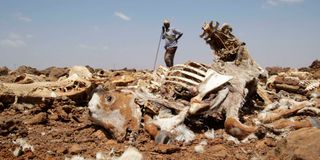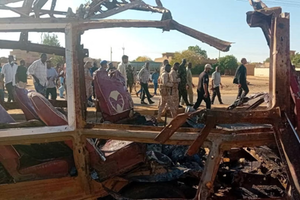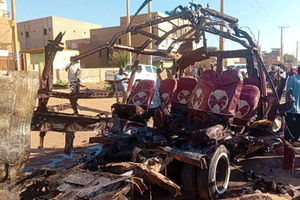
A man inspects carcasses of his livestock in Marsabit County on February 10, 2023.
As 2024 ends, the humanitarian crises in Kenya, Sudan, South Sudan, and Somalia remain dire, with millions of people enduring the devastating impacts of conflict, climate change, disease outbreaks, and displacement.
Looking ahead to 2025, the challenges are expected to continue to deepen, and urgent interventions and increased support will be needed to prevent further deterioration.
Sudan’s War on People
The ongoing conflict in Sudan, which erupted in April 2023, has had catastrophic consequences with over 20,000 lives lost and an estimated 12 million people displaced across the region. In 2024, health and humanitarian needs grew as fighting intensified and multiple health emergencies happened simultaneously.
This conflict is a war on people. Many have faced horrendous levels of violence, succumbing to widespread fighting and surviving repeated attacks, abuse, and exploitation by both the Sudanese Armed Forces (SAF) and the Rapid Support Forces (RSF).
Approximately one in six of 4,214 war-wounded patients treated by MSF since January 2024 at the Bashair Teaching Hospital in south Khartoum have been children under the age of 15 years old.
Many of these children have suffered gunshots, blasts, and shrapnel wounds. Deliberate blockages in the delivery of medicines and other essential medical supplies mean that basic emergency procedures, like treating severe burns, are impossible to undertake at the hospital.
This is amplified across the country as aid supplies reaching the country are wholly inadequate to meet the needs and belligerents continue to block aid supplies from reaching areas where they are desperately needed.
Malnutrition rates have rocketed among displaced people, particularly in camps like Zamzam in North Darfur. In February this year, MSF estimated that one child dies every two hours due to hunger in the camp.
And even after famine had been declared in the camp this August, MSF had to stop the provision of care for malnourished children at the end of September because the warring parties had blocked deliveries of food, medicines, and other essential supplies for months.
Because of the war, Sudan now sees more outbreaks of preventable diseases such as measles, partly because of the interruption of routine vaccinations, displacement and poor living conditions.
This situation is replicated in Chad and South Sudan, which are hosting refugees and returnees from Sudan. The humanitarian response must immediately scale up to meet the massive needs of the population and end this suffering.
South Sudan and Somalia’s Humanitarian Struggles
In 2024, South Sudan and Somalia faced significant humanitarian challenges, exacerbated by conflict, climate change, and inadequate healthcare.
In South Sudan, the ongoing conflict in neighbouring Sudan has triggered a refugee crisis, with over 820,000 people arriving in the country since April 2023 and overwhelming an already dire humanitarian situation.
Many of the refugees and returnees from Sudan arrive injured and acutely malnourished, facing an equally desperate situation with little food, water, or shelter. They are grappling with worsening conditions, including overcrowding and limited access to services. It is also clear that the country most impacted by climate change is also one of the least equipped to adapt to the consequences.
South Sudan is highly vulnerable to climate change, experiencing extreme weather patterns such as rising temperatures, droughts, and flooding. In March 2024, the country faced one of its most intense heatwaves, with temperatures reaching 45°C, restricting travel and causing the closure of schools and businesses.
Currently, the predicted heavy rains and flooding have impacted access to health facilities, caused displacement and reduced access to arable lands, especially in the Sudd region. This is in the face of existing reductions in the food rations granted by the WFP.
Communities are at increased risk for malnutrition, malaria and outbreaks of diseases. For instance, previous outbreaks of hepatitis E in Jonglei state were all associated with flooding and displacement.
The continuous cycles of conflict, displacement, food insecurity, and extreme poverty have created overwhelming stress, even as the stigma around mental health remains strong among communities.
In Somalia, the humanitarian crisis is similarly dire, with the country grappling with the impacts of prolonged conflict, displacement, climate change, disease outbreaks, and a looming mental health crisis. Somalia remains one of the most climate-vulnerable countries in Eastern Africa, facing recurrent droughts that have exacerbated food insecurity, leaving over 6.9 million people in need of aid. Many have been displaced to neighboring countries, including Kenya.
Somalia's healthcare system continues to face enormous challenges, including high maternal and child mortality rates, multidrug-resistant tuberculosis (MDR-TB), and high levels of malnutrition.
The country also faces a mental health crisis, with widespread trauma from years of conflict and displacement. MSF provided nearly 5,000 mental health consultations by September 2024, but the lack of funding for mental healthcare, lack of specialised professionals, and the stigma surrounding mental health pose significant barriers to care.
Kenya: Climate Change and SGBV
The effects of climate change have been devastating for communities in Kenya, with severe cycles of flooding and drought devastating communities.
Heavy rains in the first half of 2024 killed hundreds and displaced hundreds of thousands across the country. In addition to the displacement, we saw the health impacts of extreme weather changes in parts of the country like Baringo and Tana River counties.
Heavy rains after prolonged drought created favourable conditions for mosquitoes to breed, resulting in an outbreak of malaria in Baringo. In Tana River County, severe floods caused the displacement of over 43,000 people from their homes, loss of life, and destruction of agricultural activities, leading to food insecurity and risks of water-borne diseases.
Sexual and gender-based violence (SGBV) remained a critical issue in Kenya this year. In Baringo County, a needs assessment by MSF this April showed significant gaps in case detection and management of SGBV cases in the camps hosting people displaced by intercommunal conflict. Meanwhile, statistics from MSF-supported clinics in the Eastlands area of Nairobi highlighted the widespread nature of SGBV.
Between November 2023 and October 2024, MSF-supported clinics in Eastlands had treated 3,510 survivors, averaging 354 survivors per month. Six out of 10 survivors are minors with the youngest being just one-year-old. Additionally, nine out of 10 survivors are women, with a significant portion of cases involving intimate partners—at least two out of 10 survivors were attacked by someone they knew.
Men and boys are also affected, though societal stigma and lack of gender-sensitive services make it difficult for male survivors to seek help. These figures highlight the urgent need for comprehensive interventions, including better access to medical care, psychological support, and legal aid, while addressing harmful social norms and power imbalances that perpetuate violence.
Looking Ahead to 2025: A Call for Urgent Action
As 2025 approaches change, conflict and disease outbreaks will continue to create a perfect storm of challenges for people in Kenya, Sudan, South Sudan, and Somalia. At the same time, humanitarian responses to these crises are declining or inadequate to match the needs of some of these less visible emergencies.
With coordinated action, the international community can meet the humanitarian needs of millions in the East and Horn of Africa. Now more than ever, global solidarity is essential to ensure that vulnerable populations receive the medical care and support they need to survive and rebuild their lives.
Rolland Kaya is the General Director of MSF Eastern Africa.

